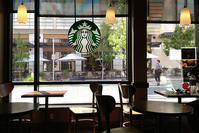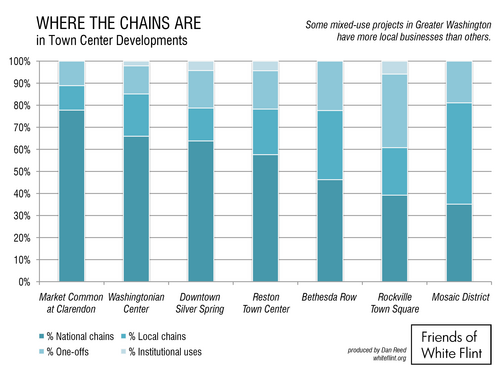Is there room for local businesses in White Flint?

Photo by dan reed! on Flickr.
New developments in urban areas often have a lot of chains. At Pike + Rose, the large mixed-use development on Rockville Pike, all of the first six restaurants to open will be chains as well. Will there be room for local businesses in the future White Flint?
Representatives from Federal Realty say their goal is to create an interesting array of shops and restaurants, no matter what they are. “It’s less important to us whether something is a chain than [having] a mix of retail types, a mix of expense points, and a mix of dining types,” says Evan Goldman, vice president of development. “We want…a diverse mix of options to get a diverse mix of people there.”
Projects like Pike + Rose can be risky. Successful retail isn’t a given even on a busy corridor like Rockville Pike, and both developers and business owners want to minimize risk. Unlike chains, which have a standard store format that’s easy to recreate, small businesses also have to design and build a space from scratch, costing money and time.
And if an entrepreneur opens a second location that fails, their business may be sunk. If a chain’s 20th store isn’t successful, existing branches can help subsidize it. That’s why developers often find it easier to work with chains in new projects.
“We know they can perform, they know they can perform,” Goldman says. “And God forbid it doesn’t perform, it’s not going to take down their company or ours.”
Where do chains go today?
When Pike + Rose is finished several years from now, it may look like other town center developments in the region, with a mix of stand-alone stores, national chains, and local chains, which I define as locally-owned businesses whose locations are primarily in the DC area. So Georgetown-based Sweetgreen counts, because all but 4 of its 20 locations are here, but Virginia-based Five Guys, which has over 1,000 locations across North America, doesn’t.
Some projects have more locals than others. They’re 22% of the businesses at the Market Common at Clarendon to 65% at the Mosaic District in Fairfax. At Bethesda Row and Rockville Town Square, both owned by Federal Realty, locals make up between 50 and 60% of all businesses.

The distribution of chains vs. local businesses at 7 DC-area town center projects. Image by the author.
Locally-owned restaurants and shops, whether one-offs or small chains, can be an asset for communities, supporting the local economy and providing unique attraction for customers. To make it easier for them to open, they need to have lower risks. There are two ways to do that: reduce the cost of doing business, or increase the potential number of customers.
How can we do that? Read the rest of my post on the Friends of White Flint..
